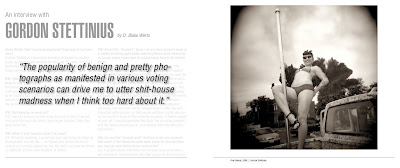I took the new instant film being produced by the
Impossible Project for my first test shoot today. The rumors on the street were this was a pretty tough film to dial in and very sensitive to temperature and light during developing. Please excuse the rough scans here (newton rings and all). I just wanted to get my first experience out there and let everyone get a feel for what worked for me and what didn't and hopefully I will start to see some other lessons learned from other shooters and we can all start to figure out this film.
These images were taken with my SX-70 Sonar. Everything was shoot in Alexandria VA, USA. For the outside shots most were in bright clear sunny conditions. Some of the last few were bright sunny hazy conditions with hazy cloud cover. The first shot was shot indoors, the exposure was a couple of seconds (guessing by the sound and delay), handheld, with the light/dark dial centered.
 1. Polaroid SX-70 Sonar
1. Polaroid SX-70 Sonar
PX100
As you can see it looks very over exposed. Either the light meter in the camera gave to much exposure or maybe this film needs less light under these conditions. The reciprocity curve might not hold out here, though if that is the case this is the first film I know of that needs less light at long exposures.
The next shot was outside in full bright sun with a clear blue sky. Again the light/dark dial was centered. This seems to be the perfect conditions for this film. This is the best contrast I got all day.
 2. Polaroid SX-70 SonarPX100
2. Polaroid SX-70 SonarPX100The next shot was of an alley way with shade and sun, same light as the above shot. Again the dial was centered. I wanted to see how it handled a very contrasty scene. The image has less contrast then above, but all in all the film did pretty good here. You can already see this film is not going to be a very high contrast film. Actually it feels very much like Polaroid Chocolate shot with a Holga.
 3. Polaroid SX-70 SonarPX100
3. Polaroid SX-70 SonarPX100This next image was shot in the same bright sun with birght blue sky, but I moved the dial one tick mark toward the darker side (giving less exposure). You can see the muddiness that results and the much less contrast. Still this has potential. It does suggest that only very minor adjustments of the dial will be necessary.
 4. Polaroid SX-70 SonarPX100
4. Polaroid SX-70 SonarPX100This image was shot an hour or so later. It is still bright and sunny, but now there was a thin layer of clouds basically turning the sky into a big bright softbox. The subjects were further away here. And all in all the contrast is way down and I did notice this film has problems with object far away, they always seem to be hazy. Dial was centered again.
 5. Polaroid SX-70 SonarPX100
5. Polaroid SX-70 SonarPX100Same exact conditions as the above image.
 6. Polaroid SX-70 SonarPX100
6. Polaroid SX-70 SonarPX100The conditions here were the same as well, but I moved the dial half way to the next mark toward the lighter side (more exposure). You do see a slight increase in detail in the tree line and the water seems brighter.
 7. Polaroid SX-70 SonarPX100
7. Polaroid SX-70 SonarPX100Finally I put the dial back to center. Same weather conditions. This time I put the film in my pants pocket and kept my hand over it to warm up the film. This film is supposed to get a red hue if the developing temperatures get to hot. You can see the added heat does start to give some red hues, it also caused the image to darken much more. Essentially this the same image as image 6 (same settings and conditions, take probably 5 minutes apart). Yet this is much darker. I now wonder if under these bright hazy conditions you might overexpose a bit and then develop in your pocket to create a better image.
 8. Polaroid SX-70 SonarPX100
8. Polaroid SX-70 SonarPX100My first impressions are that this film has potential. It is going to take some time to really dial it in and find the right lighting conditions to really make it shine. I will say it has allot of potential if you combine it with some Photoshop post processing. At the retail price this is going to be expensive to learn this film. Hopefully if enough of those who use it share their experiences we can collectively figure it out fast :)


